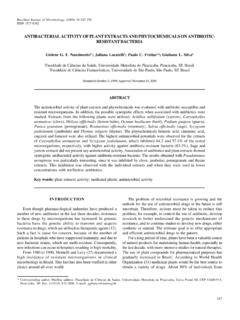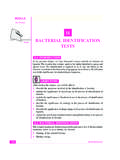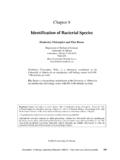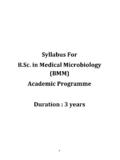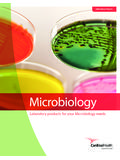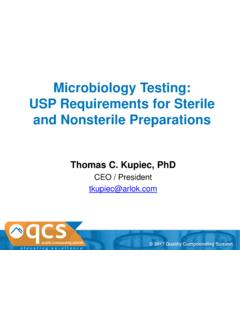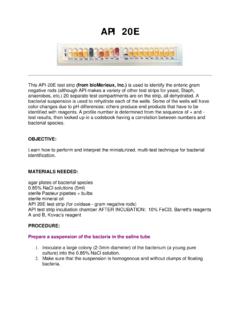Transcription of SCREENING METHODS TO DETERMINE …
1 Brazilian Journal of microbiology (2007) 38:369-380 ISSN 1517-8382369 SCREENING METHODS TO DETERMINE antibacterial activity OF NATURAL PRODUCTSC leidson Valgas1; Simone Machado de Souza2; Elza F A Sm nia2; Artur Sm nia *1 Universidade do Sul de Santa Catarina, Tubar o, SC, Brasil; 2 Laborat rio de Antibi ticos, Universidade Federal de SantaCatarina, Florian polis, SC, BrasilSubmitted: April 07, 2006; Returned to authors for corrections: September 06, 2006; Approved: February 23, emergence of new infectious diseases, the resurgence of several infections that appeared to have beencontrolled and the increase in bacterial resistance have created the necessity for studies directed towards thedevelopment of new antimicrobials. Considering the failure to acquire new molecules with antimicrobialproperties from microorganisms, the optimization for SCREENING METHODS used for the identification ofantimicrobials from other natural sources is of great importance.
2 The objective of this study was to evaluatetechnical variants used in SCREENING METHODS to DETERMINE antibacterial activity of natural products. Thus, avaried range of natural products of plant, fungi and lichen origin were tested against two bacterial species,Staphylococcus aureus ATCC 25923 and Escherichia coli ATCC 25922, by two variants of the agar diffusionmethod (well and disc), two variants of the bioautographic method (direct and indirect) and by microdilutionassay. We concluded that the well-variant of the diffusion method was more sensitive than the disc-variant,whilst the direct-variant of the bioautographic method exhibited a greater sensitivity if compared to indirect-variant. Bioautographic and diffusion techniques were found to have similar sensitivity; however the lattertechnique provided more suitable conditions for the microbial growth.
3 In this study, we also discussed thebest conditions for the determination of minimal inhibitory words: agar diffusion, antimicrobial activity , bioautographic METHODS , minimum inhibitory concentration,minimum bactericidal concentration, natural products*Corresponding Author. Mailing address: Laborat rio de Antibi ticos, Universidade Federal de Santa Catarina, Caixa Postal 476, 88040-900, Florian polis,SC, Brasil. Tel.: (48) 3331-5210. E-mail: of available antimicrobials failure to treat infectiousdiseases, many researchers have focused on the investigationof natural products as source of new bioactive molecules (15,17).A variety of METHODS are found for this purpose and since notall of them are based on same principles, results obtained willalso be profoundly influenced not only by the method selected,but also by the microorganisms used to carry out the test, andby the degree of solubility of each test-compound (20,16).
4 Thetest systems should ideally be simple, rapid, reproducible, andinexpensive and maximize high sample throughput in order tocope with a varied number of extracts and fractions. Thecomplexity of the bioassay must be defined by laboratoryfacilities and quality available personnel (8,11).The currently available SCREENING METHODS for the detectionof antimicrobial activity of natural products fall into threegroups, including bioautographic, diffusion, and dilutionmethods. The bioautographic and diffusion METHODS are knownas qualitative techniques since these METHODS will only give anidea of the presence or absence of substances with antimicrobialactivity. On the other hand, dilution METHODS are consideredquantitative assays once they DETERMINE the minimal inhibitoryconcentration (20).
5 Antimicrobial activities reported in theliterature have been evaluated with diverse sets ofmethodologies, degrees of sensitivity, amount of test-compounds and microbial strains, often difficult to this reason, our purpose is to suggest somerecommendations and establish criteria for the use ofbioautographic and diffusion nia-Jr., A. et AND METHODST ested natural productsFourteen extracts, seven fractions (obtained by partitioningand chromatographic fractioning of crude extracts) and 10 purecompounds from natural resources were tested (Table 1). Thefungi derivatives were supplied by Laborat rio de Antibi ticos,Universidade Federal de Santa Catarina, plant derivatives werekindly provided by Professor Moacir Geraldo Pizzolatti(Universidade Federal de Santa Catarina) and lichen derivativesby Professor Neli Honda (Universidade Federal de Mato Grossodo Sul).
6 Natural products used were selected by previousantimicrobial activity SCREENING using diffusion method againstat least one of the two bacterial strains used during the solvents used (dichloromethane - Nuclear,dimethylsulphoxide - Nuclear, and ethanol - GrupoQu mica) to dissolve and dilute the natural products dependedon the method used to evaluate their activity . For the diffusionmethod well-variant, the solvent used was dimethylsulfoxide(DMSO) and for the remaining methodologies, suitable solventswere used for the dissolution of the natural products. Thus,alcohol, water:alcohol and ethyl-acetate fractions, and purecompounds were dissolved and diluted with ethanol:water (8:2).Chloroform and dichloromethane extracts and fractions weredissolved and diluted with ethanol:dichloromethane (8:2), hexane,and petroleum-ether extracts and fractions were dissolved anddiluted with ethanol: dichloromethane (6:4).
7 Test-bacteriaThe antibacterial activity of natural products was assessedagainst two bacteria species: Staphylococcus aureus ATCC25923 (American Type Culture Collection, Rockville, MD) andEscherichia coli ATCC 25922, maintained in BHI at 20 C; 300mL of each stock-culture were added to 3 mL of BHI cultures were kept for 24 h at 36 C 1 C and thepurity of cultures was checked after 8 h of incubation. After 24h of incubation, bacterial suspension (inoculum) was dilutedwith sterile physiological solution, for the diffusion and indirectbioautographic tests, to 108 CFU/mL (turbidity = McFarlandbarium sulfate standard ). For the direct bioautographic test,bacterial suspension was diluted with BHI broth to a density ofapproximately 109 UFC/mL (McFarland standard 3).
8 Indicator solution for determination of bacterial growthA 70% ethanolic solution of 2-(4-iodophenyl)-3-(4-nitrophenyl)-5-phe nyltetrazolium chloride (INT) (2mg/mL)purchased from Sigma was used for the bacterial growth methodsIn order to suggest methodologies for SCREENING the naturalproducts antimicrobial activity , two different qualitativemethods were evaluated as follows: agar diffusion test,employing two different types of reservoirs (filter paper discimpregnated with compound-test and wells in dishes) andbioautographic method (agar diffusion and chromatogramlayer). Besides, we discussed the aspects of the microdilutionmethod used for the determination of minimum inhibitoryconcentration (MIC).Agar diffusion well-variantThe bacterial inoculum was uniformly spread using sterilecotton swab on a sterile Petri dish MH agar.
9 Nine serial dilutionsyielded concentrations of 100, 80, 60, 40, 20, 10, 5, , and for extracts and fractions and four serial dilutions yieldedconcentrations of 20, 15, 10 e 5 mg/mL for pure substances. 50 L of natural products were added to each of the 5 wells (7 mmdiameter holes cut in the agar gel, 20 mm apart from one another).The systems were incubated for 24 h at 36 C 1 C, under aerobicconditions. After incubation, confluent bacterial growth wasobserved. Inhibition of the bacterial growth was measured inmm. Reference commercial discs were used (chloramphenicol30 mg purchased from Cecon and vehicle, 50 mL). Tests wereperformed in duplicate (18).Agar diffusion disc-variantNatural products were dissolved and diluted with solventsas mentioned previously.
10 Same number of subsequent dilutionswas performed as described above. However, natural productsserial dilutions were performed out of initial concentrations than the ones performed for well-variant method ( mg/mL for extracts and fractions and 50 mg/mL for puresubstances); 7 mm filter paper discs (Whatman, no. 3) wereimpregnated with 20 mL of each of the different dilutions. Thediscs were allowed to remain at room temperature until completediluent evaporation and kept under refrigeration until ready tobe used. Discs loaded with natural products were placed ontothe surface of the agar. Commercial chloramphenicol discs (30mg) and paper discs impregnated with 20 mL of diluents used todilute natural products were used as control. Tests wereperformed in duplicate (20).
